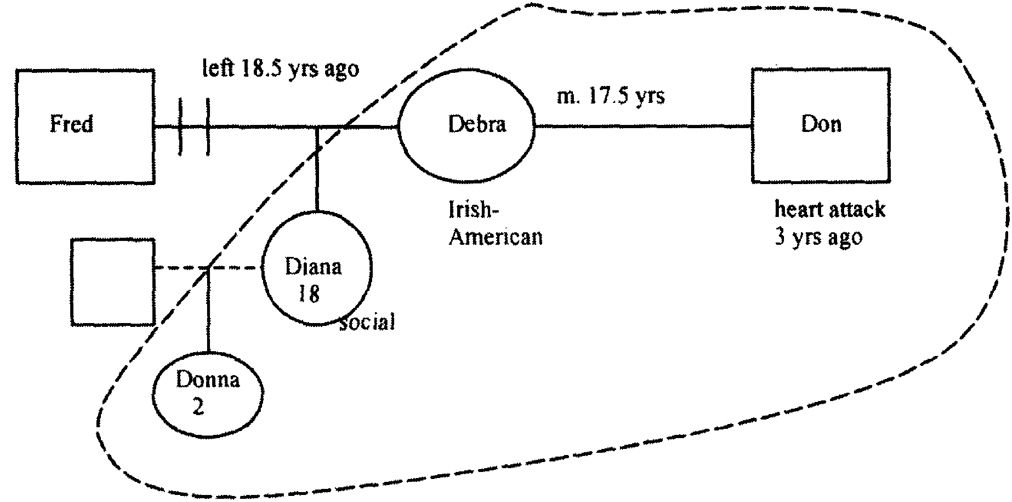
- •Isbn-10: 1-4338-0549-9
- •Introduction
- •The Palo Alto Team
- •Murray Bowen
- •Salvador Minuchin and Structural Family Therapy
- •Strategic Family Therapy
- •Solution-Oriented Therapy
- •Narrative Therapy
- •Psychoeducation Family Therapy and Medical Family Therapy
- •Multisystemic Therapy
- •Multidimensional Family Therapy
- •Figure 3.1
- •Figure 3.1 (Continued)
- •The Patient’s Symptom as a Function of Unresolved Family Issues
- •Figure 4.1
- •The “Patient” in Family Therapy
- •Two Against One: Triangulation and Intergenerational Coalitions
- •The Pursuer–Distancer Dance
- •Collaboration and the Role of the Larger System
- •The Role of the Therapist
- •The Role of the Patient and Family
- •Goal Setting
- •Enactment
- •Circular Questions
- •Externalizing the Problem
- •Family Sculpting
- •Positively Connoting the Resistance to Change
- •Genograms and Time Lines
- •Building on Family Strengths
- •Figure 4.2
- •Family Psychoeducation for Schizophrenia
- •Adolescent Conduct Disorders
- •Adolescent Substance Abuse
- •Childhood Behavioral and Emotional Disorders
- •Anorexia Nervosa in Adolescence
- •Alcohol Abuse in Adults
- •Interventions With Physical Disorders
- •Ideas and techniques that cut across models of family therapy
Figure 4.1
Genogram of Diana’s Family

The therapist said: “Really? Before you got pregnant?”
Diana: “Three months before.”
As the family talked more about their history, it became clear that they associated pregnancy with loss (as when Fred left Debra) and that Don’s heart attack had threatened both his wife and daughter with a new loss. Diana’s pregnancy repeated this old theme, an intergenerational transmission of a pattern related to the potential loss of a father being associated with the birth of a baby. But this time, Don survived his heart attack, and Don and Debra wanted even more to enjoy their time together so that the baby became a source of struggle as well as joy.
Without taking a biopsychosocial family history, none of this information would have emerged. The meaning the family gave the pregnancy was not only about their “baby” having a baby but also carried the weight of these unresolved issues of loss related to Diana’s biological father. There were many aspects to this therapy, but part of it had to do with Diana learning more about him and his relationship with her mother.
The “Patient” in Family Therapy
Any case can be understood from a family systems perspective, no matter how many people are in the therapist’s office for help. Sometimes the referral is for one person, as with Diana who was labeled as the patient, and the family is both collaborator and participant in the treatment. Research on treatment for depressed individuals, for example, shows that couples counseling can be as or more effective for patients with depression (Beach, 2002), and psychoeducation for families of patients with schizophrenia or bipolar disorder can prevent or reduce relapse rates (Milkowitz & Goldstein, 1997). Sometimes the referral focuses on a relationship, such as with marital therapy, and the relationship becomes the “patient.” In any case, the therapist completes a biopsychosocial evaluation, eliciting the individual, relationship, and social factors that contribute to the continuation of the problem, as occurred with Diana and her family. A systemic treatment plan, then, focuses on the level or levels of the system in which the therapist, patient, and family can get the most leverage for change.
Two Against One: Triangulation and Intergenerational Coalitions
Joey, age 10, was brought to therapy because he refused to go to school. Rick and Sally, his father and stepmother, begged and cajoled him every morning, sometimes plying his fingers off the bathroom towel railing and carrying him kicking and screaming to school. Joey often lasted at school about 2 hours; then the school staff called Sally, who worked from home, to pick him up because he was so disruptive. Without her husband at home and wanting to be a “good” rather than “evil” stepmother, Sally worked hard to calm Joey down with video games and homemade cookies. In truth, Sally thought Rick was too hard on his son, and occasionally she said so to Joey, feeling he had a right to know. Sally was also disappointed that Rick worked much longer hours after their marriage than before. Joey became her project, and they developed a warm relationship, except for the morning struggles over school. Sally did not see, until several sessions of therapy, how her warm behavior might result in Joey’s desire to avoid the challenges of school. Rick, for his part, did not see that his distance and strict approach to parenting left him on the long side of the triangle, with his wife and son being closer, on the short sides. The treatment plan involved meetings with Rick and Sally to bring them closer and put them in charge, together, of Joey’s behavior.
Intergenerational coalitions happen with some frequency in families who present for therapy. The longer and more entrenched they are, the more difficult the treatment. Treatment consists of detriangulation, of helping the parents, or parenting figures, to work out their differences so that no adult sides with a difficult child against the other adult. The child can then feel safe and secure in what is expected of him or her, and the parents can feel closer in their shared goal of successfully raising their child.
